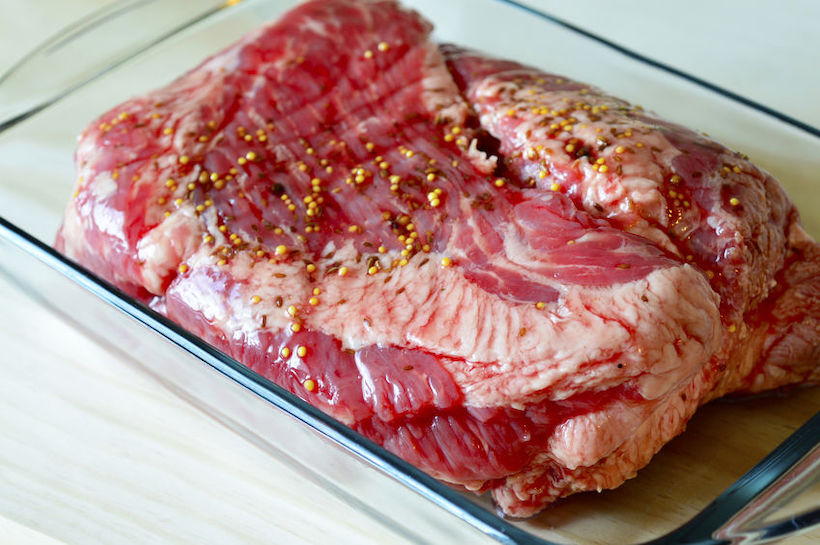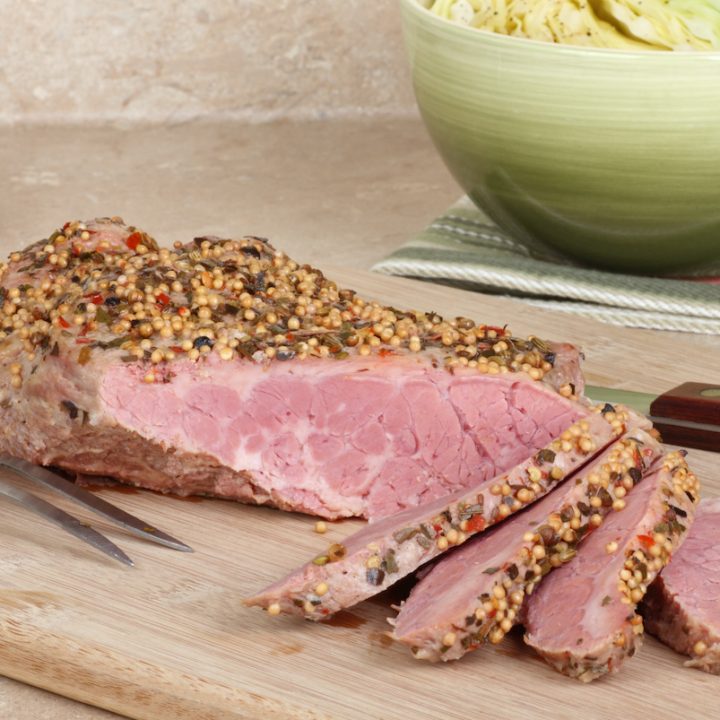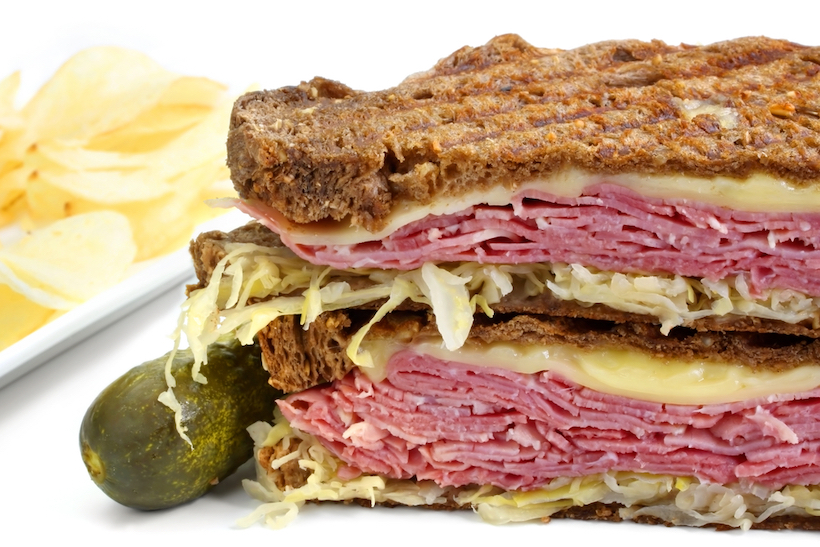I never questioned our St. Patrick's day meal choice as a kid. Corned beef, cabbage – makes sense, right?
Today I'm no longer a kid, though, and the history of corned beef and its association with St. Patrick's day is fascinating to me. In this post, I'll distill what I've learned about the dish, its history, pairings, and everything else I could find out.
Pull up a chair, let's discuss corned beef!
Before digging into its past, I admittedly thought corned beef was a product of relatively modern times.
I was surprised to learn corned beef has an incredibly rich history that dates as far back as the 12th century. Let's take a closer look.

In essence, corned beef is simply beef that has been cured using salt and other ingredients. The 'corn' in corned beef isn't the ear of corn you might be thinking of, but instead, British slang for the large pieces of salt used to preserve the corned beef.
The process of making corned beef is a long one and involves using large amounts of salt, nitrates, and spices. Initially, (typically – especially for modern store-bought meat) making corned beef consists of some type of brine that is very similar do the kind of liquid that used for pickling vegetables.
In that sense, you can say corned beef is a pickled meat of sorts. After submerging the meat in the brine, at least 5-7 days need to go by before a brisket can be called corned beef. Apart from preserving it from spoiling (both salt and nitrates are preservatives), the curing process helps tenderize and soften the meat, making it very easy to slice when everything is cooked up.
Here's an interesting fact: we don't know where and when corned beef was invented. The earliest recorded reference to the food dates to a Gaelic piece of poetry from the 12th century, Aislinge Meic Conglinne ("The Vision of MacConglinne").
Then MacConglinne arose. "Is Pichán asleep ?" he said.
"I will tell truth," answered Pichán. " If Cathal were to remain as he is to the brink of Doom, I shall not sleep, I shall not eat, nor smile, nor laugh."
"Get up," said MacConglinne. And he called for juicy old bacon, and tender corned-beef, and full-fleshed wether, and honey in the comb, and English salt on a beautiful polished dish of white silver, along with four perfectly straight white hazel spits to sup-port the joints.
Aislinge Meic Conglinne ("The Vision of MacConglinne"), 12th Century
Wherever corned-beef arose, its ties to the country of Ireland are undeniable – and they run very deep. Ireland was the first region where the export of corned beef became a common and widespread phenomenon. Strangely, though, Irish consumption of corned beef lagged behind its production – the Irish traditionally ate more bacon and pig products than beef. As beef was more expensive, corned beef was limited to special occasions and festivals instead of an everyday meal.
The British Cattle Acts of 1663 and 1667 kicked off the corned beef trade in earnest. As Ireland couldn't export live cows anymore, they instead bootstrapped a trade in corned beef – the majority of it through the Southwestern city of Cork.
Salt beef quickly (by 1670-1680) became the most significant export by volume from the British Isles. At that point, a considerable quantity was traded to the English colonies, or for sugar with the French West Indies, or instead used in a three-way trade with rum and flax seeds. Both France and England proper also traded a significant amount of Irish corned beef.
After those early days of trade, the corned beef industry continued to boom. As a preserved product, it was effective on long voyages – and immensely useful to the navies of (primarily) France and England.
Ireland mostly retained its dominance of the preserved beef trade until the late 19th century. Then, canning plants in South America started to sell salted "bully beef" around the world – a product that gained a ton of popularity due to its usage in the 2 World Wars.

Corned beef remained one of the most critical exports of Ireland until the middle of the 19th century. At this point, other countries (including those in South America as well as the United States) began producing their corned beef.
In the 19th century, the Irish Potato Famine wiped out an alarmingly large portion of the population. Many of those who survived emigrated to other countries. All these conditions had a devastating effect on the production of corned beef in the country.
However, Irish migrants in the United States maintained the costume of eating corned beef on social and special occasions – and as we'll discuss, increased their usage of corned beef.
Nowadays in America, corned beef is primarily known for its association with St. Patrick's Day.
However, before easy and convenient refrigeration, salting or pickling beef and pork was a common way to preserve meat. Corned beef figures in many historical meals dating to the country's founding – and even in the United States' space efforts.
With your freezer and refrigerator, you don’t need to worry too much about how you store your food. However, there was a time when that wasn’t the case. If you didn’t have easy access to fresh meat, you’d have to find a different way to preserve your food. Enter pickling.
Salt is a preservative, but for curing meats, nitrates (and actually, nitrites) are most important for safety. Clostridium botulinum – which causes botulism – is the biggest risk to aged or cured meat.
Nitrates and nitrites are dangerous in sufficient quantities – but at the proper concentration, they kill bacteria without harming us. They also cause the pinkish color you associate with cured meats like corned beef – nitrites bond with hemoglobin to create methemoglobin.
So, be careful with the nitrates – but know they were (and are!) necessary ingredients for preservation. This recipe from 1823 shows a traditional mix for pickling beef or pork:

"Pickle for Beef and Pork" from The New England Farmer, Vol. II No. 21 December 20, 1823
The recipe doesn't include times – generally, you would need more than 5-6 days in the mixture. Here's what the instructions stated:
In making a larger or smaller quantity of pickle the above proportions are to be observed. Boil and skim these ingredients well, and when cold put it over the beef and pork.
The following recipe for making pickle for beef or pork is strongly recommended for the adoption of those who pickle beef and pork for family use. Persons in the trade who will adopt it will find a ready sale for their beef and pork. It has been used by many families in this city and always approved. I do not hesitate to say that there is no pickle in use to be compared with it It is familiarly known by the name of the Knickerbocker Pickle. Could this recipe be generally adopted, our pickled beef and pork would have certain preference in foreign markets.
* - Saltpetre is potassium nitrate. Bacteria converts to nitrate to nitrite in solution, which in turn bonds to hemoglobin in meat – giving cured meats like corned beef their infamous pink color. A modern mix could use a lower amount of nitrite directly and skip the conversion.
** - Pearl ash or "potash" is potassium carbonate. Baking soda is a reasonable substitute.
And pickling works – corned beef and other preserved meats were very popular through the 1700s through the early 1900s in the United States. They extended to every class and population too – Abraham Lincoln even had corned beef at his First Inaugural Luncheon.
Corned beef became a symbol of the Irish people due to the vast number of Irish emigrants who flocked to America during the Irish Potato Famine. Lacking easy access to the pigs they had eaten back home, many Irish in New York instead turned to corned beef as a dietary staple.
The Irish found that corned beef (and other cured meats) represented an affordable source of protein. What is more, corned beef can be stored for long periods, making it very practical for buying in large quantities at discounted prices. In addition, the Irish were used to the taste of preserved pig and beef from their homeland, making it a relatively easy transition.
As a result, Irish settlers had various dishes that used that type of cured meat, including the famous corned beef and cabbage.
Interestingly, the proximity of Irish settlers in New York with Jewish communities also may have affected the uptake of salted beef among the Irish. As I previously mentioned, the migrant Irish who went to America took with them their love of corned beef. However, many historians maintain that this love was rekindled and revived by the interaction the Irish had with Jewish settlers who lived in the same neighborhoods – where corned beef was a butcher's staple.
At this point, the Jewish also had adopted cured beef into their lifestyle and culture. For that reason, the Irish often bought brisket or already corned brisket from Kosher delis to produce the corned beef they loved so much. This phenomenon also helped combine curing techniques from both cultures to create a new "version" of corned beef: modern American corned beef.
Many people know that St. Patrick's Day is an Irish national holiday. However, not everyone is aware that corned beef has a very close historical relation with St. Patrick's Day. Let's get right into it!
Saint Patrick was a Romano-British Christian missionary and bishop in Ireland who lived during the fifth century. During the latter half of his life, he was a missionary who fought to bring Christianity to Ireland, making it the official religion of a country that, until then, practiced a sort of Celtic polytheism.
There are many legends and stories of Saint Patrick performing miracles. The most well-known, however, is probably his banishment of all snakes from the country of Ireland. St. Patrick's legacy as the Patron Saint of Ireland is celebrated every March 17.
When Irish emigres moved from Ireland to the United States, most had minimal resources and very limited purchasing power. For that reason, corned beef was one of their go-to sources of protein.
It's not surprising, then, that the cured meat was used to create a humble celebratory dish that reminded settlers of their homeland: Corned Beef and Cabbage. To this day, this dish is served on St. Patrick's Day in Irish homes across the world.
Of course, St. Patrick's Day is one of the most celebrated national holidays in Ireland. However, other countries have an Irish population large enough to warrant St. Patrick's Day celebrations – plus others enjoy the festivities as well.
Without a doubt, the United States of America has one of the largest communities and celebrations annually. Cities like New York and Boston have large Irish populations, and large celebrations annually. Chicago also celebrates in style – every St. Patrick's day, they dye the Chicago River green to celebrate. Even Washington, D.C. gets in on the celebration – the White House recently began dyeing the fountain out front green every year.
Celebrations aren't limited to Ireland and the United States, however. Argentina, for example, is home to the largest St. Patrick's Day celebration in all of South America. The United Kingdom also has large St. Patrick's Day celebrations since England, Scotland, and Wales are home to many people with Irish heritage. Since 1922, there is even a St. Patrick's Day parade held every year in Japan that was created by Irish ex-pats who wanted to introduce Irish culture to their new neighbors.
Now that you are caught up with the overview of corned beef and its relation with St. Patrick's Day let's talk about the food in modern times.

If you thought corned beef is only suitable for traditional Irish dishes like corned beef and cabbage, think again. Over the years, people have imagined a variety of ways in which corned beef can be used – it's a worthy addition to your rotation.
Some of the most practical alternative uses of corned beef involve bread. There are various ways in which you can use the food to make a great sandwich, even in small quantities. Two of the most famous corned beef sandwiches are the classic deli sandwich and the famous Ruben. However, there are other, more creative alternatives such as corned beef and cheese melts or corned beef and cabbage sliders.
If you are looking for something more interesting than sandwiches, don't worry. There are plenty of creative uses you can give to corned beef.
For example, you can combine unraveled leftover corned beef with cheese to make a great dip. Serve with celery sticks, cauliflower florets, and crackers for a fantastic snack for your guests. In the same vein, try corned beef nachos made by sprinkling leftover corned beef pieces over the chips with melted cheese on top.
There are many types of cured meats that are, at heart, similar to corned beef. However, the cured meat that gets compared to corned beef the most is, without a doubt, pastrami.
The two have a ton in common - both are nowadays made from brisket, although corned beef comes from the leaner side and pastrami from the fattier. They also share a similar brining process – you can essentially start with a brined brisket and end up with either.
Where they differ is in the cooking. Corned beef is cooked in liquid or water and spice, braised into the delicious meat and feature of my post today. Pastrami goes the other route – it's rubbed with spices, then smoked or baked to perfection. Pastrami also usually includes a bit more sugar in the brining mix (but recipes vary!).
Another similar meat is Montreal smoked beef. Montreal is brined like corned beef and pastrami, but with less or no sugar. It's then rubbed and smoked, with an independent spice mix from pastrami. You can kind of look at it as a hybrid of corned beef and pastrami – although Montreal smoked beef fans say pastrami wishes it were close in taste.

I'd be remiss if I didn't mention one of the more infamous places corned beef turned up - around 120 miles above the surface of the earth during the Gemini-3 mission.
Astronaut John Young smuggled a can of corned beef onto the ship and proceeded to attempt to eat a sandwich! For about a minute, Young and Astronaut Gus Grissom discuss the sandwich – which unfortunately started breaking up once Young bit in.
(His report: it tasted excellent.)
All in all, getting to today's corned beef was a fascinating journey, with a lot of interesting history.
The next time you bite into corned beef – on St. Patrick's day or not, and with cabbage or not – you'll have a fuller history as you fill-up. Enjoy your meal!
Wow, great article! It satisfied my curiosity about the origins of corned beef!
An excellent article. I discovered a recipe for Hamburgh Pickle in a manuscript cookbook that I have. The book dates from the 1820s. I needed to know more about the recipe. I found you on Google and your article has answered so many questions. Thank you.
Thank for this interesting history of Corned Beef and the Irish